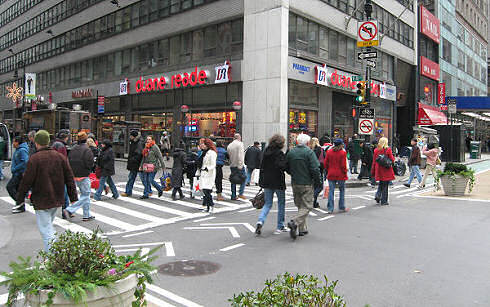[John Ciccarelli is a consultant on bicycling, League of American Bicyclists Cycling Instructor and member of the Bicycle Technical Committee of the National Committee on Uniform Traffic Control Devices. These comments are based on his observations during a field trip to examine bicycle facilities in New York City in December of 2008.]
For me, the pedestrian conflicts on a new unconventional Manhattan bikeway — on the pedestrian-enhanced blocks of Broadway starting south from Times Square — rendered that bikeway nearly useless — even though those blocks of Broadway are similar to the
9th Avenue layout in several ways:
- Both streets are multi-lane one-way-southbound
- Both have a left-curbside one-way bikeway
- At intersections there is a bike signal and a left-turn pocket and turn-arrow for motor vehicles (where the cross street is two-way or one-way-left)
However, instead of a door-zone-buffered in-street parking lane beside the left-side bikeway, the city has removed one or two travel lanes and created an in-street pedestrian “plaza”, completed with a right-side fence-and-planter barrier, cafe tables, chairs and benches. It’s truly a bold stroke in taking back the street for living, and it was immediately and hugely popular with residents and visitors, but it creates horrendous pedestrian cross-flow issues for the bikeway that runs between it and the sidewalk. Compounding this is the sheer volume of pedestrians on the left (east) side of Broadway in the enormously popular Times Square area. Although the sidewalks are wide here, even on a cold December day they were simply not up to the task of conveying the volume of walkers present. As a result — especially with the in-street ped plaza removing the motor-traffic hazard — the left-curbside bikeway simply became an extension of the sidewalk. Also, near Times Square, a large fraction of pedestrians are tourists, who seemed to be even more oblivious than apparent natives to the fact that they were stepping into space that the City had designated for bicycle travel, despite its continuous green color and white legends. On many blocks I found the Broadway bikeway completely unsafe at “city” bicycle travel speeds.
Interestingly, on the one block immediately north of the Broadway bikeway’s starting point by Times Square, the city has placed an in-street barrier one lane out from the left (east) curb expressly to create a sidewalk extension. I didn’t know what that area was for (it has no signage or markings) until I asked a NYC police officer, who confirmed that was its function. So a walker proceeding south along Broadway’s east sidewalk could easily and legally walk in this protected street area, cross the next cross-street, and assume that it’s OK to just keep walking in the “protected” street despite this funny green area with bike symbols.
[This has changed. As of the summer of 2009, several blocks of Broadway north of Times Square are now a pedestrian plaza, curb to curb — John Allen]
Broadway’s new layout had pedestrian conflicts both at mid-block (because of the in-street “plaza”) and at intersections (due to ped volume overwhelming the corner storage capacity). The mid-block situation could be mitigated somewhat by creating a continuous barrier in the sidewalk “furniture strip” to the left of the bikeway, with a few well-marked gaps each block to channelize pedestrians to/from the in-street plaza — maybe even with “crosswalk” markings. But I saw no way to address the corner capacity problem short of removing one more vehicle travel lane and transferring its width to the sidewalk. There’s a whole lotta walkers in NYC, especially near attractions like Times Square.
On most of the transformed blocks, the right (vehicle traffic) side of Broadway’s in-street pedestrian plaza is defined by a continuous line of large planters and fence segments. The resulting essentially impenetrable edge effectively deters double parking, loading/unloading, and pickup/dropoff activity along the leftmost vehicle travel lane. I thought the whole bikeway+”plaza” configuration could have worked much better if the bikeway was removed from curbside, the “plaza” shifted leftward to become a true extension of the sidewalk with its street-side planter+fence boundary intact, and a “conventional” left-side bike lane striped along the planter+fence boundary, still free from double-parkers. This left-side bike lane could proceed straight across the start of intersection left turn pockets at the ends of blocks where cross streets were two-way or one-way-left, and would not require a bike signal so it would get as much green time as the adjacent mixed-flow through lanes.

